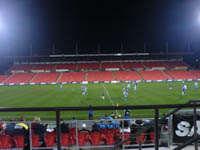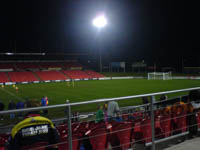Penrith Stadium – until 2024
| Capacity | 22 500 |
|---|---|
| Country | Australia |
| City | Penrith |
| Clubs | Penrith Panthers |
| Retire year | 2024 |
| Other names | Credit Union Australia Stadium (2006–2010), Centrebet Stadium (2011–2013), Sportingbet Stadium (2014), Pepper Stadium (2015–2017), Panthers Stadium (2017–2021), BlueBet Stadium (2021–2024) |
| Inauguration | 23/04/1967 |
| Address | Mulgoa Rd & Ransley St, Penrith NSW 2750 |
Advertisement
Penrith Stadium – historical stadium description
What was the former Penrith Stadium like in brief?
Penrith Stadium opened in April 1967 and was initially equipped with an oval-shaped playing field. In the 1980s, the pitch was converted to a rectangular layout, with new stands built along the sidelines. In 2006, the western grandstand was further expanded.
At that stage, the venue featured two grandstands along the sides of the field, while the ends were flanked by grassy embankments where spectators could also sit. Floodlight masts stood in the corners, and the arena’s capacity reached 22,500.
It served as the main stadium of Penrith, a distant western suburb of Sydney located over 50 km from the city’s central business district. Due to sponsorship agreements, the stadium was known under various names – the last of which was BlueBet Stadium.
The primary tenant of Penrith Stadium was the rugby league team Penrith Panthers, competing in the National Rugby League (NRL). In the final years of the old stadium’s existence, the team enjoyed remarkable success, securing four consecutive premierships from 2021 onwards.
The old ground was demolished between April and August 2025 to make way for the new Penrith Stadium – larger and more modern, though still retaining much of the previous venue’s character. The new stadium is expected to be ready for the start of the 2027 season.
When was Penrith Stadium opened?
The first match at Penrith Park was played on 8 April 1967, when the Penrith Panthers faced the Newtown Jets (16–10). The official inauguration took place shortly after, on 23 April 1967, when the venue was opened by Harold Matthews, vice president of the NSW Rugby League.
From the very beginning, the stadium primarily served the Penrith Panthers rugby league team, for whom the 1967 season was their debut in the New South Wales Rugby League (the predecessor of today’s National Rugby League).
How was Penrith Stadium expanded?
The ground originally had an oval shape. It was surrounded by low earth embankments, and a modest main grandstand stood on the western side. The stadium was completely transformed in the 1980s, when the playing field was converted to a rectangular shape and new stands were erected along the pitch.
The last major expansion came in 2006, when the western grandstand was enlarged with a new southern section and new corporate boxes were added.
What events were hosted at Penrith Stadium?
The main tenant of Penrith Stadium was the rugby league team Penrith Panthers, competing in the prestigious National Rugby League (NRL). The team had played at the venue since its opening and secured six premiership titles there, including four in a row in the final years of the old stadium’s existence (2021–2024).
Apart from the regular fixtures of the Penrith Panthers, the stadium occasionally hosted other teams and competitions. For example, in 1984–1985 it was the home ground of football club Penrith City FC.
In 2008, the venue staged two matches of the Rugby League World Cup. It also hosted other international rugby league fixtures, as well as matches of the Australian women’s national soccer team.
What names did the Penrith Panthers’ home ground have?
Although most commonly known as Penrith Stadium or Penrith Park, the venue bore a variety of names over the years due to frequent changes in naming-rights sponsorship. Between 2006 and 2010 it was known as Credit Union Australia Stadium, followed by Centrebet Stadium (2011–2013), Sportingbet Stadium (2014) and Pepper Stadium (2015–2017).
In the following years, without a naming sponsor, the ground was renamed Panthers Stadium. From 2021 onwards, under a new agreement, it carried the name BlueBet Stadium.
What did Penrith Stadium look like?
The venue was located in Penrith, on the far western outskirts of Sydney. It featured a rectangular playing field, which, apart from rugby league, also allowed for soccer and rugby union matches. Along the sidelines were two-tiered stands, partially roofed at the upper levels. The main stand, containing corporate boxes and facilities, was situated on the western side.
Behind the northern and southern ends of the field were grassy embankments from which fans could also watch the games. The northern embankment was known as Family Hill. The stadium was equipped with floodlights and video screens, and its capacity stood at 22,500.
When was the old Penrith Stadium demolished?
In mid-2021, the Government of New South Wales announced its intention to redevelop Penrith Stadium. The first details of the plan were unveiled in early 2024. According to the concept, the old venue was to be demolished and replaced by a new, more modern arena, while still retaining a similar character.
The last match at the old Penrith Stadium took place on 13 September 2024. The demolition of the stands was carried out between April and August 2025, after which construction of the new stadium began. Works are expected to be completed in 2026 so that the new venue will be ready for the start of the 2027 season.
Advertisement
Pictures
2022
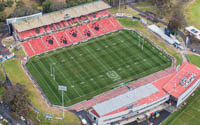
2022 © Penrith Panthers 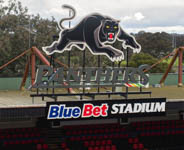
2022 © Penrith Panthers
2021
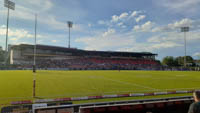
13.03.2021 © Jason L (CC BY-SA 4.0) 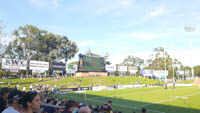
13.03.2021 © Jason L (CC BY-SA 4.0)
2016
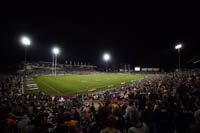
2016 © Penrith Panthers
2011
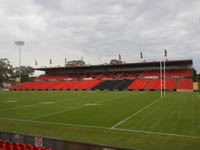
17.02.2011 © S.A.Mc9 (CC BY-SA 3.0) 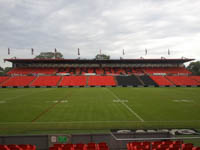
17.02.2011 © S.A.Mc9 (CC BY-SA 3.0)
2008
Related news
2024
-

Australia: BlueBet Stadium to be renamed Penrith Park for final match
The Penrith Panthers are set to honor their home ground by renaming BlueBet Stadium to its original name, Penrith Park, for their Round 27 game against the Gold Coast.
-

Australia: Sydney Stadium modernization getting closer
Penrith is planning to develop its sports base through projects of plans for a new stadium presented by the New South Wales government. What exactly will be created?

 StadiumDB
StadiumDB